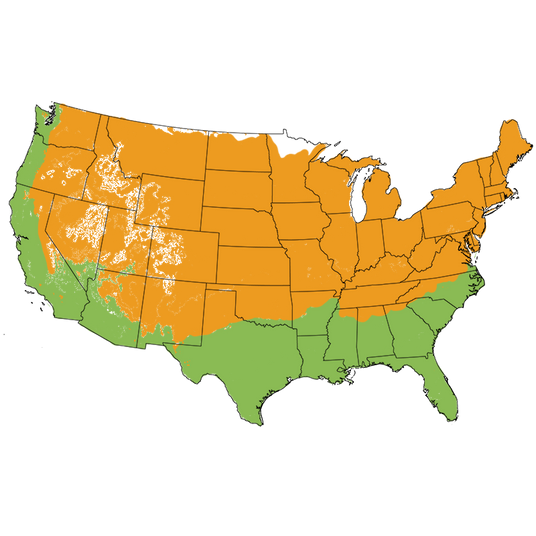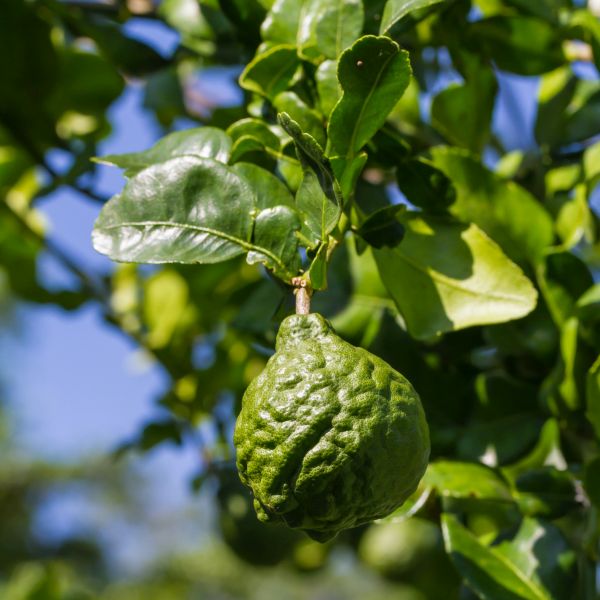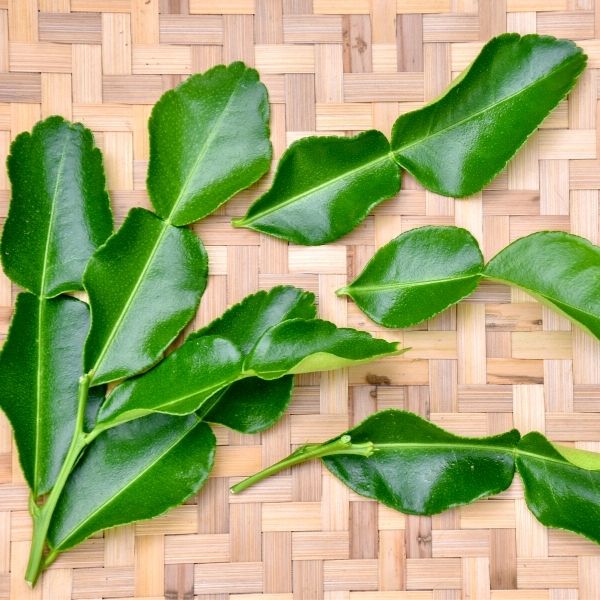Kaffir Lime Tree
Citrus hystrix 'Kaffir'
- Stay Protected with Plant Sentry ™
Kaffir Lime Tree - #3 Container 2-3 Feet is backordered and will ship as soon as it is back in stock.
Plant Sentry™
Plant Sentry™

Plant Sentry™ Protected
Your order is protected by our compliance system that:
- Prevents restricted plants from shipping to your state
- Ensures plants meet your state's agricultural requirements
- Protects gardens from invasive pests and diseases
Delivery and Shipping
Delivery and Shipping
Delivery and Shipping
Fast, Safe Plant Delivery
Ships in 3-4 business days • Tracking provided • Weather protected
| Under $50 | $9.99 |
| $50 - $99.99 | $14.99 |
| $100 - $149.99 | $16.99 |
| $150 - $198.99 | $24.99 |
| $199+ | FREE |
✓ Zone-specific timing • ✓ Professional packaging • ✓ Health guarantee
Understanding Plant Options
Nature Hills offers plants in two main formats:
- Container Plants: Grown in pots with soil, sized by container volume and plant age
- Bare Root Plants: Dormant plants without soil, sized by height measurements
Container Plant Sizes
Container sizes indicate plant age and growing capacity rather than liquid volume equivalents. Our containers follow industry-standard nursery "trade gallon" specifications, which differ from standard liquid gallon measurements.
Young Plants (6 months to 18 months old)
| Container Size | Actual Volume | Metric Equivalent |
|---|---|---|
| 2" x 2" x 3" | 0.18 - 0.21 dry quarts | 0.20 - 0.23 dry liters |
| 4" Container | 0.31 - 0.87 dry quarts | 0.35 - 0.96 dry liters |
| 4.5" Container | 0.65 dry quarts | 0.72 dry liters |
| 6" Container | 1.4 dry quarts | 1.59 dry liters |
| 1 Quart | 1 dry quart | 1.1 dry liters |
| 5.5" Container | 1.89 dry quarts | 2.08 dry liters |
Established Plants (18 months to 2.5 years old)
| Container Size | Actual Volume | Metric Equivalent |
|---|---|---|
| 2 Quart | 2 dry quarts | 2.2 dry liters |
| #1 Container | 2.26 - 3.73 dry quarts | 2.49 - 4.11 dry liters |
| 5" x 5" x 12" | 3.5 - 4.3 dry quarts | 3.85 - 4.74 dry liters |
Mature Plants (2-4 years old)
| Container Size | Actual Volume | Metric Equivalent |
|---|---|---|
| #2 Container | 1.19 - 1.76 dry gallons | 5.24 - 7.75 dry liters |
| #3 Container | 2.15 - 2.76 dry gallons | 8.14 - 12.16 dry liters |
Large Plants (3-5 years old)
| Container Size | Actual Volume | Metric Equivalent |
|---|---|---|
| #5 Container | 2.92 - 4.62 dry gallons | 12.86 - 20.35 dry liters |
| #6 Container | 5.25 - 6.01 dry gallons | 23.12 - 26.42 dry liters |
| #7 Container | 5.98 - 6.53 dry gallons | 26.34 - 28.76 dry liters |
Bare Root Plants
Bare root plants are sold by height from the root system to the top of the plant. Plants may exceed minimum height requirements.
Common Sizes:
- Trees: 1 foot, 2 feet, 3 feet, 4 feet, 5 feet, 6 feet
- Shrubs & Perennials: 1 foot, 18 inches, 2 feet
Important Notes
Container Volume Specifications
- Trade Gallon Standard: Our containers follow industry-standard "trade gallon" specifications established by the American National Standards Institute (ANSI Z60.1) for nursery stock
- Volume Variations: Actual soil volume may vary due to plant root systems and growing medium settlement
- Age Indicators: Container size primarily indicates plant age and maturity rather than liquid volume equivalents
Growing Conditions
- Plant size can vary based on variety and growing conditions
- Container size helps indicate plant maturity and establishment level
- Larger containers generally mean more established root systems and faster landscape establishment
Seasonal Availability
- Bare root plants are available seasonally when dormant
- Container plants are available throughout the growing season
- Specific varieties may have limited availability in certain sizes
Questions?
For questions about specific plant sizes or availability, please contact our plant experts who can help you choose the right size for your landscape needs.
Plant Highlights
Kaffir Lime Tree highlights at a glance!
-
Botanical Name
-
Brand
-
Growth RateModerate
-
Mature Height
-
Mature Width
-
Leaf Color
-
Flower Color
-
Pollinator FriendlyYes
-
Pollinator Required
-
Bloom PeriodLate Spring
-
FragrantYes
Characteristics
Where To Plant
When To Prune
- Late Spring
Water & Moisture Needs
- Moderate
Sunlight Needs
Soil Needs
- Well-Drained

Growing Zones
Culinary Kaffir Lime
- Prized Culinary Plant
- Grows Well in Containers
- Great Aromatic Patio Plant
- Delicious Leaves Season Asian Dishes
- Dwarf Citrus Tree
- Full Sun Lover
- Powerful Juice
- Exotic Appearance
- Acid-Loving, Low Moisture
- Beautiful Accent Tree
Grow your own Thai spice and save money. Grown for year-round culinary interest, Kaffir Lime (Citrus hystrix 'Kaffir'), is a dwarf fruit tree that is highly prized for its leaf which is used in different types of Southeast Asian cuisines, primarily recipes from Thailand, Indonesia, Cambodia, and Laos.
Much like Bay Leaves or Lemongrass, the Kaffir leaf and the fresh lime zest of the fruit add an enormous amount of flavor. You'll love creating your own Thai curries and stir-fries with the freshest possible ingredients.
Defined by the doubled-lobed leaf that appears to be 2 different segments, the essential oil from the Kaffir Lime's leaves is in high demand throughout the world.
The fruit is used mostly for the rind. Scrape the outside to harvest zest and add to prepared foods and drinks. The powerful juice is used for specialty household uses and is very effective when prepared correctly.
How to Use Kaffir Lime in the Landscape
Because the Kaffir Limes pungent leaves are the primary interest, this is one the few plants that has a year-round culinary purpose. If you're a cook and love great Thai food, having a year-round source of one of the pricier main ingredients is a must.
Originating from Sri Lanka, a small island nation off the east coast of South Africa, the demand for the Kaffir Lime spread east into Southeast Asia and the Indonesian Islands. Today, the Kaffir Lime is known by over 20 different names worldwide.
The small tree makes a beautiful accent tree in the landscape. It can be utilized as a screen or hedge plant.
The tree's famous foliage remains a rich dark green year-round. Kaffir Lime is a lovely little tree, with double-lobed, dark green leaves that catch the sun with their glossy sheen.
Funky fruit adds a ton of texture to the overall appearance. Use a zester and scrape lightly along a washed piece of fruit. You'll love the extra "oomph" it adds to your meals. The small, green limes produced by your Kaffir have a bumpy exterior, which is an attractive addition to an already exotic appearance.
Kaffir is well adapted to container growing and will do well as an indoor-outdoor plant. As a patio plant or indoor houseplant, your Kaffir Lime is sure to bring a taste of the tropics to your home.
Because it thrives in potted environments, you can use it to decorate your front porch or patio. Its delightful citrus scent will brighten your home and landscape.
Imagine growing your very own delicious ingredients for some of the world's most popular dishes - right at your fingertips! It doesn't get much better than that.
#ProPlantTips for Care
Give the Kaffir Lime well-drained soil, and keep it on the dry side while indoors. Don't overwater this tree.
The growth rate is moderate, so maintaining its size is very easy. It takes pruning very well and can be maintained to any size and almost any shape with pruning.
When bringing the Kaffir indoors for the winter, make sure and provide it with as much direct sunlight as possible, at least 6 hours a day and up to 10. Select a south-to-southwest-facing window, if possible.
This is one of the few Citrus that is a bit more tolerant of less light. Because the fruit is not as critical, the plant will adapt to lower light situations, but it will perform best with morning sun and afternoon shade.
Protecting Container Citrus From Cold
Although it's famous for growing in warmer regions, it can also thrive in colder areas as long as the tree is brought indoors prior to the first frost of winter.
If you're growing these tropical trees in the ground in the lowest of their favored growing zones, they need to be planted in a sheltered spot to avoid the worst of the chill. If a spot like that is unavailable, then you are better off planting in a large, deep container.
In borderline growing zones, begin slowly acclimating your tree indoors or into a protected location, eventually moving your tree inside in bright indirect sun for the winter if the temperatures in your area ever dip below that 40°F range. In spring, reverse this process and begin acclimating your tree to again be back out in the full sun all summer. This reduces stress and leaf drop.
Kaffir Lime can also be grown outdoors year-round in zones 9-11. If in-ground, feed quarterly with Dr. Earth Life Organic and Natural All-Purpose Fertilizer.
For container feeding, use fertilizer applied quarterly. Citrus in containers prefers a pH below 6.5 and benefits from an acid-based fertilizer.
Kaffir Lime trees are a popular item. Order now before they sell out and enjoy the benefits of growing your own fresh Asian seasonings.
Delicious Kaffir Lime Sparks Controversy
The Kaffir Lime has a long history of varied usages, from perfume to shampoo, to insecticides, and as a key ingredient in many countries' culinary preparations. Still, with its long-appreciated history, its name remains controversial to this day.
The Kaffir Lime is known by many other names and spellings. Kafir lime, Caffre lime, Kieffer lime, Makrut, Magodo, or simply Thai lime. Noteworthy is the fact that the name Kaffir is a terribly offensive word in many parts of the Middle East and Africa.
Citrus hystrix was first named Kaffir in 1824 by Augustin Pyramus Candolle, a renowned Swiss botanist, who at the time headed the University of Montpellier in the southeast of France.
Candolle received seed from the famous Garden of Mauritius, an island off the coast of Madagascar. The plants from which the seeds originated from were thought to be from Thailand or Sri Lanka, where an ethnic group known as the Kaffirs lived.
The name, it is said, originates from an Indian Arabic term that conveys otherness and exotic provenance. The origins of the name continue to rage in horticultural circles.
The Kieffer (its alternative spelling) Lime, as some have chosen to call it, now represents an important part of Thai, Indonesian, Chinese, Philippine, and Vietnamese cooking. The leaves are the primary part used in many dishes. They can be fresh, dried, or frozen. The powerful essence from the rind is also used for many applications as well. In Creole cooking, the zest is infused into rum to add flavor.
For the chef, growing the Kieffer lime tree may be the best alternative to trying to buy the leaves and or fruit. Both can be quite difficult to find and can be quite expensive. The trees are easy to grow and are widely adapted.












